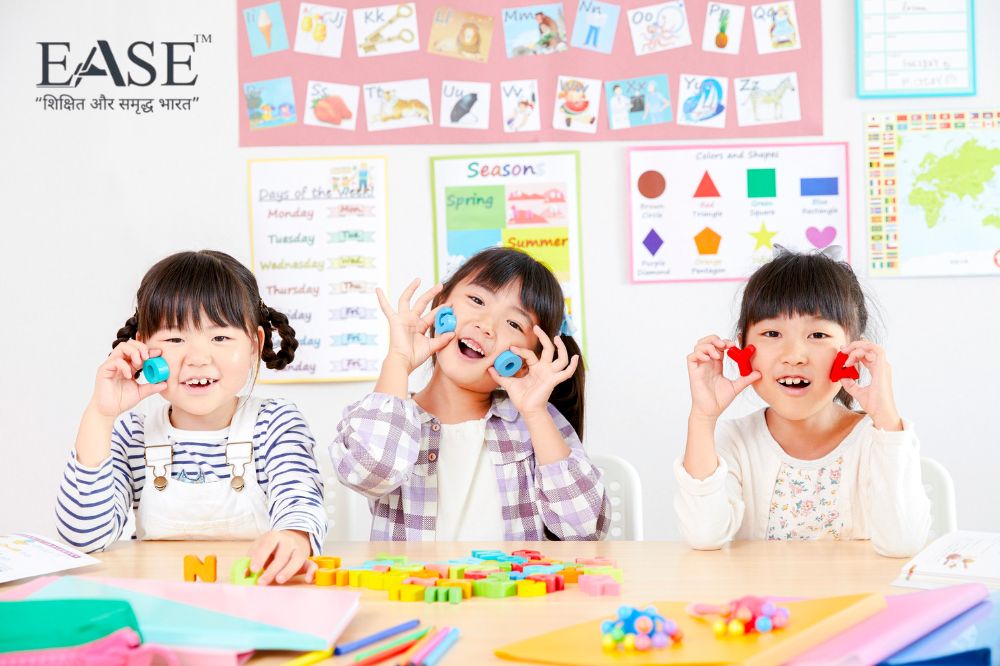Children aged 3 to 4 are in a golden phase of development. They’re curious, energetic, and eager to explore the world around them. The right activities at this age don’t just entertain—they build the foundation for learning, confidence, and emotional growth.
Whether you’re a school designing a nursery curriculum or a parent looking for daily engagement, this guide from EaseEdu covers everything you need to know.
Development Goals for 3–4 Year Olds
Activities should support:
| Area of Development | What It Builds |
|---|---|
| 🧠 Cognitive Skills | Thinking, problem-solving, memory |
| ✋ Fine Motor Skills | Hand-eye coordination, writing readiness |
| 🏃 Gross Motor Skills | Balance, strength, physical confidence |
| 🗣️ Language & Communication | Vocabulary, listening, expression |
| ❤️ Emotional & Social Skills | Sharing, empathy, self-regulation |
| 🎨 Creativity & Imagination | Artistic expression, pretend play |
Indoor Activities (Classroom & Home)
1. Color Sorting with Pom-Poms or Buttons
Helps with color recognition and fine motor control.
2. Play Dough Fun
Strengthens fingers and sparks creativity. Try making animals or alphabets.
3. Story Time with Puppets
Improves listening and language. Let kids act out parts with finger puppets.
4. Shape Hunt Around the Room
Ask children to find circles, squares, triangles in everyday objects.
5. Sensory Bins (Rice, Sand, Water)
Hide small toys or letters for kids to discover through touch.
6. Cup Stacking Challenge
Boosts hand-eye coordination and focus.
Outdoor Activities to Boost Energy
1. Pompom Hockey or Balloon Tennis
Fun and active. Great for coordination and teamwork.
2. Nature Walk & Object Collection
Collect leaves, stones, flowers. Discuss colors, shapes, textures.
3. Mini Obstacle Course
Use cushions, cones, and tunnels. Add challenges like “hop like a bunny.”
Role of Education in Skill Development
4. Water Play Stations
Buckets, cups, and sponges—perfect for summer and sensory fun.
5. Bubble Chase or Ribbon Dancing
Encourages movement and joy. Great for group play.
Creative & Art-Based Activities
1. Fork Painting or Finger Painting
Explore textures and patterns. Use bright colors.
2. Foil Drawing with Toothpicks
Unique and fun—kids love seeing their art shine.
3. Cup Animals or Paper Plate Faces
Crafts that teach shapes, emotions, and storytelling.
4. Spring Play Dough Garden
Use scented dough and flower petals to create a mini garden.
5. Painting Pots or Stones
Let kids decorate small pots or pebbles with paint and stickers.
Academic Readiness Activities
1. Alphabet Songs & Dance
Catchy tunes help with letter recognition and phonics.
2. Counting Collections (1–20)
Use beads, blocks, or stickers to practice counting.
3. Matching Games (Colors, Shapes, Letters)
Simple cards or toys make learning interactive.
4. Tracing Letters in Sand or Flour
A sensory twist on writing practice.
5. Recognizing Letters & Sounds
Use flashcards, whiteboards, or cereal boxes for letter spotting.
Sensory & Emotional Activities
1. Ice World Exploration
Play with ice, water, and sea-themed props.
2. Jelly Hide & Seek
Hide small toys or letters inside jelly for kids to squish and find.
3. Feelings Chart or Emotion Faces
Help kids identify and express emotions through drawings or role play.
4. Quiet Corner with Soft Toys & Books
A calming space for self-regulation and rest.
Parent Tips for Daily Activity Time
EaseEdu recommends:
- Set aside 30–45 minutes daily for structured play
- Use everyday items (cups, spoons, cushions) creatively
- Celebrate small wins—claps, stickers, or high-fives
- Join in! Kids love when parents play too
- Mix indoor, outdoor, and quiet time activities for balance
FAQs – Nursery Activities for 3–4 Year Olds
Q1. What are the best activities for 3-year-olds at home?
👉 Sensory play, storytelling, painting, sorting, and matching games.
Q2. How long should activity time be for nursery kids?
👉 30–45 minutes of focused play, with breaks for free play and rest.
Q3. Can these activities be done in school and at home?
👉 Yes! Most use simple materials and can be adapted easily.
Q4. How do these activities help in learning?
👉 They build motor skills, language, social confidence, and early academic concepts through play.
Q5. What if my child doesn’t sit still for activities?
👉 That’s normal! Choose movement-based or short activities and let them explore freely.
Q6. How can schools track progress through activities?
👉 Use observation sheets, photo journals, and weekly feedback reports—EaseEdu provides templates for this.
Partner with EaseEdu for Smarter Nursery Programs
EaseEdu helps schools design engaging nursery programs that combine:
- Age-appropriate curriculum
- Teacher training for activity-based learning
- Parent engagement tools
- Growth tracking and feedback systems
- Custom activity kits and seasonal themes
Let’s build a joyful learning journey for every child—where play meets purpose.
👉 easeedu

